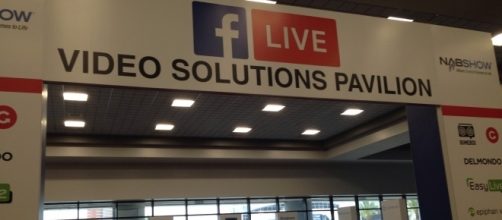It seemed only fitting that before launching into his annual, vigorous defense of local TV and radio stations around the country, NAB President Gordon Smith opened his association’s keynote address on Monday in Las Vegas by announcing that NASA will live stream 4K Ultra HD video from the orbiting International Space Station on Wednesday for the first time in history courtesy of Amazon. That an online retailer/cloud provider would have the honor to make this kind of historic leap, rather than NBC, CBS, or another major network, was not lost on attendees at this week’s major broadcasting convention in Las Vegas, Nevada.
They’ve seen the future, even when it’s coming at them from 250 miles above the earth.
For many years, the NAB Show has traditionally been attended by major television and film executives who talk about programs, news shows, movies and production tools to deliver content for the media-hungry masses, all while casting a wary eye on the changing digital landscape that threatens to upend legacy models. This year, change landed squarely in the trade show halls and conference session tracks where major technology players such as Facebook, Amazon, and Google seemed to dominate the conversation. As Smith himself put it on Monday, “The media landscape seems to be changing in the blink of an eye.”
Google Cloud offers help to traditional TV
Although Amazon made a splash on the first day with their glitzy space age announcement, more significant news came from Google Cloud.
In his keynote address later on Monday, Tariq Shaukat, Google’s cloud division president, announced that the search giant’s dynamic ad insertion platform, which has helped monetize online channels in the digital world, would also be made available to traditional TV broadcasters as well. Google also announced a new virtual reality (VR) camera (in partnership with Yi Technology), that will complement their VR production platform called Jump.
This latter news is important because producers in the VR space have been wrestling with the problem of how to stitch together footage from the 360-degree view in less time than it took to make “Gone With The Wind.” According to Shaukat, Google’s advances in the VR platform and cloud technology will let producers do what used to take weeks in a matter of hours.
Google also offered TV and film producers a tantalizing glimpse into the potential impact of machine learning on their craft. Examples were shown where computers, which can now recognize what a leafy plant looks like, can quickly search for all scenes in which such an image appears, thus saving untold amounts of time.
Facebook partners showcase tools for live stream
Facebook’s presence at NAB was defined this week not by their own dedicated exhibit, but through an area where partners showcased their tools to enable Facebook Live. The video streaming platform for Facebook has attracted unwanted publicity in recent days through the recording and posting of a murder in Cleveland, Ohio and a similar incident this week when a Thai man horrifically killed his daughter and then himself.
As troubling as this form of live broadcasting may seem, the future implications are to democratize the news in ways that traditional television never envisioned. To this end, one of Facebook Live’s partners – The Video Call Center – introduced a digital profanity delay tool called BleepIT yesterday at NAB that would remove unwanted material from the live stream.
Throughout the conference venues in Las Vegas are signs and posters heralding this year's NAB theme of “The M.E.T Effect,” which stands for “media, entertainment, technology.” Based on the active involvement of some very big tech firms this week, the last letter may well be the most important to broadcasters.

